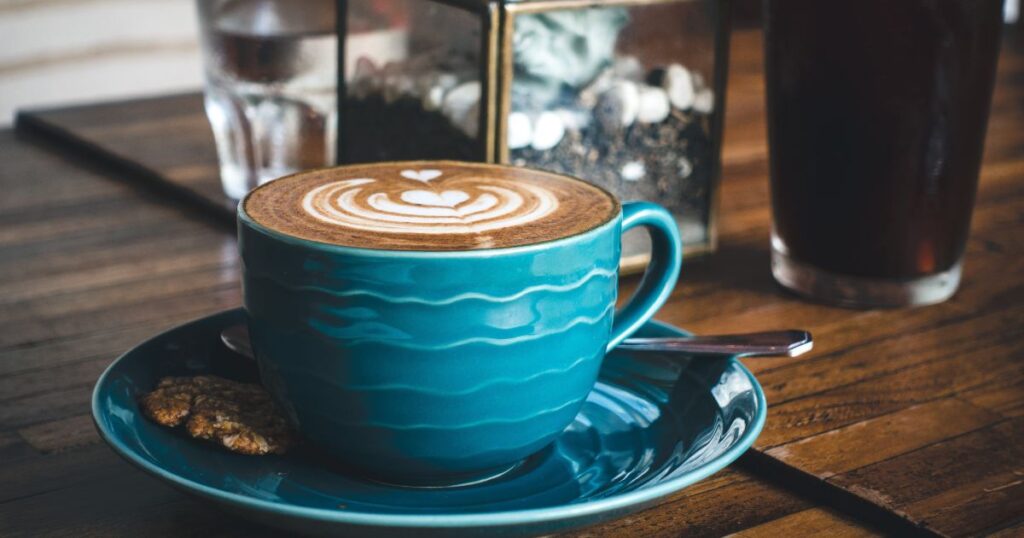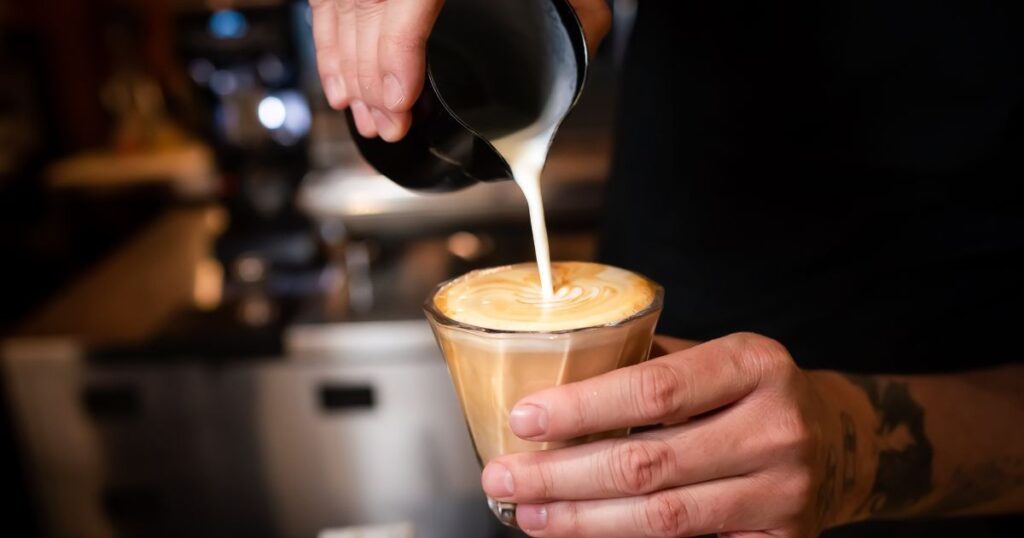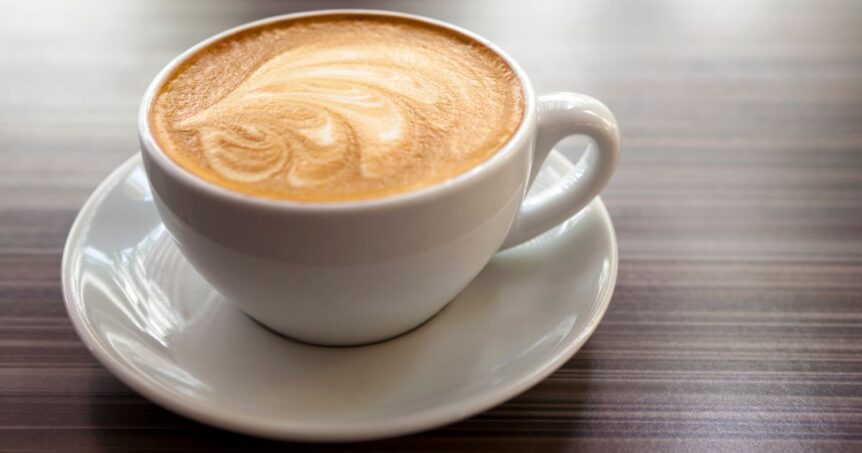Flat White is a specialty milk coffee made with just two simple ingredients: espresso shots and micro-foamed steamed milk. Sounds simple, right? Try telling that to coffee aficionados who dive headfirst into the nitty-gritty of the recipe, the techniques, and the never-ending origins debate. Sheesh!
But it doesn’t have to be confusing. Get ready to dive into the fascinating world of this coffee craze as we explore the ins and outs of flat white.
Learn how to craft your very own cup and uncover the captivating history behind this beloved beverage in this complete guide to flat white.
What does Flat White Mean?
The name “Flat White” actually comes from the signature thin layer of foam, about 0.5 cm (~1/4 in) thick, floating on top of the drink. The milk is aerated just right to give it that smooth and silky feel. It creates a perfect balance of milk and coffee and is served in a cute little 6 oz ceramic cup or a heat-proof glass.
The History of Flat White

The origin of the mouthwatering Flat White coffee is a matter of contention between Kiwis and Aussies.
The Aussies claim that the Flat White was born on their shores around the 1960s. However, the most authentic evidence we have dates back to the mid-1980s with a review of a Sydney café called Miller’s Treat. The review, published in “The Sydney Morning Herald,” mentioned the presence of “Flat White” on the café’s menu. Talk about solid evidence!
On the other hand, New Zealand claims Flat White’s origin based on the statement of barista Frasher McInnes. According to Frasher, in 1989, he accidentally created the drink when his attempt at a frothy cappuccino using low-fat milk resulted in minimal froth.
However, Frasher humbly acknowledges that there may have been other flat white recipes that came before his happy accident.
Who Invented Flat White Coffee?
Australia, mate! They’ve got the goods to back it up with legit evidence like tabloids and newspapers from the 1980s. Sorry, Kiwis, but we’ve gotta give this one to the Aussies. Fair dinkum!
Nonetheless, we Americans get to enjoy the delicious coffee, and we are thankful to all who contributed to the development of Flat White.
Where is Flat White from?
Flat white is a popular drink in Europe and Australia, with its roots going back to mid-1980. According to Craig Miller, author of “Coffee Houses of Wellington, 1939-79: The Pre-Espresso Period,” flat white is a bit of a mystery. It’s a “generic drink” that evolved without any clear inventor or specific birthplace.
It became the go-to coffee in America since Starbucks introduced it in 2015. The recipe slightly changes from place to place.
What is Flat White Made of?
The original flat white from Australia and New Zealand is made from two shots of espresso and steamed milk served in 6 oz cups. The key here is the lesser quantity of milk and micro froth. However, courtesy of Starbucks, the American variant makes one with a double shot of pullover ristretto served in 12-20 oz cups. It’s a much more diluted version of the original flat white.
How Much Caffeine is in the Flat White?
A regular flat white served in a coffee shop has about 70 to 140 mg of caffeine per serving. In comparison, Starbucks Flat White has about 130 mg of caffeine.
How Many Calories are in a Flat White?
A typical, flat white cup served in cafes has about 120 calories. Starbucks Tall (12 oz) Flat White has about 170 calories. You can order one made from skim milk which reduces the calories in half.
How to Make a Flat White? 3 Easy Ways

Flat white is one of the easiest specialty coffees you can make right in your own kitchen. Here we are going to explain three easy ways to brew this drink.
Spoiler alert! You don’t even need an espresso machine. More about it later.
Using Espresso Machine
Step 1: Espresso shots
First, grind about 19-20g of fresh coffee beans to a fine grain size. Distribute the coffee grounds evenly and tamp them. Attach the portafilter to the machine and extract double shots of espresso into a 6 oz to 8 oz cup. We recommend an extraction time of 25 to 30 seconds to achieve a rich coffee flavor without going overboard.
Step 2: Steaming the milk
This is where things get a bit tricky, so pay attention. Remember, we’re making a flat white, which means we want to minimize the foam.
Start by purging any residual steam in the machine. Take 4 oz of milk and begin steaming it until you hear a hissing sound. Steam it for a few seconds, aiming to achieve a smooth and silky texture without creating too much froth.
Give it a few gentle swirls, and when you’re ready, pour the warm milk into the cup with the espresso. Coffee art is optional but can add a nice touch to your creation.
Without an Espresso Machine
What if you don’t have an espresso machine? Don’t worry, we’ve got you covered. Just little tweaks in the recipes here and there and you will get something similar to the original in taste.
Step 1: Brewing Coffee
Use any standard burr grinder for coffee beans, but unlike the ones in espresso, we want a coarser grind size. Use 18g of coffee grind, but we will add more water to the final ratio making the final extract close to 60 to 70g. A typical espresso shot is 35 to 40g.
We did this to get a similar taste of espresso but with stovetop coffee makers like Moka Pot and Aeropress.
Suppose you are using a moka pot start by filling the hot water to just below the valve. Put the ground coffee in. No need to tamp it.
Put it on medium heat and let it brew. When the water just starts to boil, remove it from the stove. You now have a perfect brew for a flat white.
Step 2: Steaming the Milk
Heat the milk for about 65 degrees Celsius (150°F) and use a handheld frother or blender to aerate the milk. And voila, you are good to go. Pour it into the cup and enjoy.
Using Instant Coffee
We know coffee drinkers might raise their eyebrows, but instant coffee can be a convenient option in a pinch when you don’t have any brewing equipment on hand. Sometimes, simplicity saves the day.
Add 1 tsp of coffee and 3 tsp of sugar into the cup. Pour three to four tbsp of hot water and mix it.
Heat the milk (140-145°F) and aerate it using a blender for a few seconds. Pour the milk into the cup, and you are good to go.
Flat White Recipe
Here’s a recipe for making flat white coffee. Remember, you can always make some changes here and there to suit your taste. At the end of the day, coffee should make you feel happy!

Equipment
- Espresso machine or alternative coffee brewing method
- Coffee grinder (if using fresh coffee beans)
- Milk jug or pitcher
- Steam wand (part of an espresso machine) or milk frother
Ingredients
- 1-2 shots of espresso
- 4-6 fluid ounces of milk
- A small amount of microfoam for latte art optional
Instructions
- Brew 1 or 2 shots of espresso using an espresso machine or substitute with a stovetop espresso maker or strong brewed coffee.
- While the espresso is brewing, heat the milk. Pour the milk into a small stainless steel milk jug or pitcher. Use enough milk to fill about 2/3 of the jug to allow room for steaming.
- Steam the milk using an espresso machine or a frother, positioning the wand just below the surface, frothing with a small amount of air, and gradually moving it downward for even heating.
- Continue steaming until the milk expands slightly. The ideal milk temperature for a flat white is around 150-155°F (65-68°C). Be careful not to overheat or oversteam the milk, as it can affect the taste and texture.
- Pour steamed milk over espresso shots, starting close to the surface, pouring slowly, and gradually raising the jug for latte art if desired.
- Serve immediately and enjoy your flat white coffee!

Frequently Asked Questions
What is the Difference between Flat White and Latte?
Flat white and latte are completely different drinks in taste and appearance. Both have 1-2 shots of espresso, but lattes have more milk and froth. Typically, lattes have 8-16 oz of milk and 1 cm of milk foam, while flat white has 6 oz of milk and 0.5 cm of microfoam. You can say the latte is a more milky version of flat white.
What is the Difference between Flat White and Cappuccino?
Cappuccino has a thick layer of foam of about 2 cm, which usually takes the shape of a dome. In contrast, the flat white has a thin layer of milk foam around 0.5 cm. The higher quantity of milk and froth in cappuccino makes the taste a bit creamier than a flat white.
What is the Point of Flat White?
Flat whites are for those people who want a greater kick from the espresso shot, all the while not diluting the drink with milk like in lattes or excess foam like in cappuccino. It’s a no-nonsense milk coffee that is growing in popularity.
Why are Flat Whites So Popular?
Because it tastes good! Double espresso shots with just the right amount of smooth textured milk and a tiny foam layer make the perfect blend. Australians and New Zealanders were already fond of this drink since 1980s, and now slowly, it’s becoming the go-to coffee for many Americans too.
What Type of Person Drinks a Flat White?
Flat white drinkers are the no-nonsense type who like their milk coffee strong, without any fancy extras like excess milk or foam.
How Much Milk Flat White?
A typical serving has approximately 4 to 6 ounces of steamed milk.
How Much Coffee is in Flat White?
A typical serving has 1 or 2 espresso shots, which equals around 20 to 40 grams of pure coffee goodness.
Is Flat White Good?
Yes! It’s one of the few specialty coffees that are trending and growing in popularity as we speak. Flat white is like a creamy coffee dream with a punch of bold espresso and a velvety smooth texture. Mmm, perfection!
How Many Shots Are In Flat White?
A flat white has 1 or 2 shots of espresso. In America, espresso is often replaced by ristretto to get the extra kick.
Final Thoughts
Kudos to you if you’ve made it to the end. We’re confident that you’re now equipped to go toe to toe with any connoisseur when it comes to brewing or ordering the perfect flat white.
The world is diverse, and so is the coffee culture, which evolved differently in different places in the world.
You may come across slightly different recipes and brewing techniques for a flat white, but in the end, it depends on your preferences. Cheers to the flat-white revolution!

